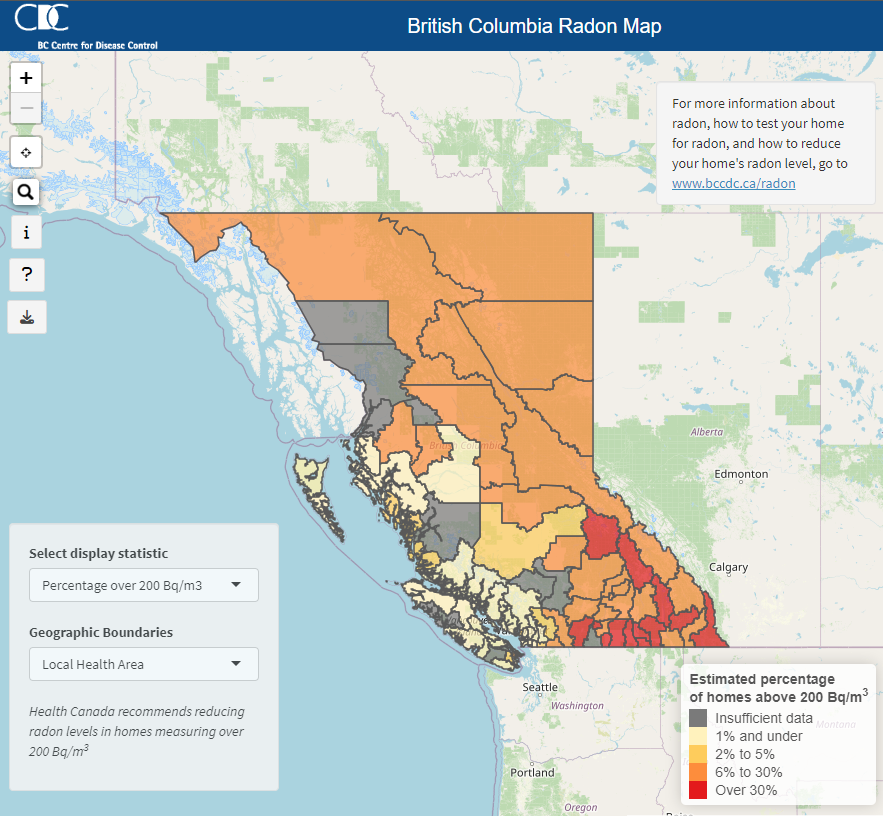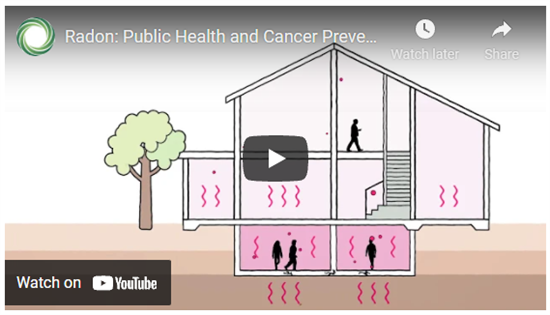Radon released from the ground can build up indoors and pose a risk to your health.
____________________________________________________________________________________
_____________________________________________________________________________________
Radon is a naturally occurring colourless, odourless, radioactive gas that is released when uranium breaks down in soils and rocks. Radon released from the ground into outdoor air gets diluted and is therefore not harmful. However, radon is a problem in indoor settings, where it can build up and pose a risk to your health.
Watch the video below by
BC Cancer on how radon can impact health:
Being exposed to radon does not produce any immediate symptoms, but long-term exposure to radon – at any level but especially at high levels – can cause lung cancer.
The risk of developing lung cancer due to radon is even higher for smokers. It is the leading cause of lung cancer for non-smokers and the second leading cause for smokers.
Lung cancer caused by radon is preventable because there are ways to reduce the amount of radon in your home.
Due to geological factors, some areas in British Columbia have naturally higher surface levels of radon than others. Many of these areas are in the Interior and Northern parts of the province.
However, indoor radon accumulation can vary widely from building to building, even in the same neighbourhood. Even if you live in an area with generally lower levels of radon, it is still recommended that you test your home for radon.
The interactive map below displays indoor radon levels recorded in homes across B.C. It also shows estimates for the increase in lung cancer risk caused by radon (both overall and for smokers).
Click the image below to see the map.

The radon data used in this map is from the British Columbia Radon Data Repository (BCRDR), which houses de-identified indoor radon readings from across the province. The BCRDR includes radon readings from a variety of building types, but only residential readings were used to create this map.
Radon can seep into your home through any opening that is in contact with the ground. It can move through cracks in the foundation, gaps around pipes, floor drains, and window casements. This can happen in both new and old homes.
In general, radon levels are highest in the lowest levels of a building, such as a basement.
Radon levels can vary greatly from house to house because the accumulation of indoor radon depends on several factors, including how much uranium is naturally in the soil of the region, how much the foundation of the home was sealed during its construction, and how much ventilation occurs in the home.
The only way to know how much radon is in your home is by testing for it. Testing is recommended in all homes, especially those who live in areas with higher levels of radon and who smoke.
Radon is measured in a unit called Becquerels per cubic meter (Bq/m3). Radon released from the ground into outdoor air gets diluted to about 5 to 15 Bq/m3 and has little impact on your lung health. However, when it accumulates indoors, it can reach much higher levels and increase your risk of lung cancer.
Testing can be done using a do-it-yourself radon test kit or by hiring a professional certified by the Canadian National Radon Proficiency Program.
- Radon levels can vary greatly from season to season, and even day to day, so the most accurate way to find out if your home has a problem is to do a long-term test over a period of at least 90 days.
- This test uses a small device that measures the radioactive particles emitted by radon. After the testing period, the device is then sent to a lab for analysis.
- It is recommended that you place the device in the lowest level of your home where you spend at least 4 hours a day, for at least 90 days over winter, when the house is likely to be more sealed.
- Short-term testing can be done using a device over a period of days to weeks. Since radon levels can vary day to day, short-term testing should not be used alone to determine if your home has a problem.
- It can be useful in instances where a home has had a known high level of radon in the past and you want to confirm that the level of radon has dropped after being fixed.
- Any initial short-term test should always be followed up with a long-term test.
- Both short and long-term test kits can be purchased online or from home improvement stores.
- An accredited long-term kit can also be purchased through the BC Lung Foundation which includes the laboratory fee.
- Short-term test kits are also available for loan at some public libraries in BC through the Radon Detector Library Lending Program.
- Your community can also receive free test kits through the Take Action on Radon 100 Test Kit Challenge program.
Find a Radon Test Kit Provider Near You
Health Canada recommends that home improvements take place within two years if radon levels are above 200 Bq/m3, and within one year if the levels are above 600 Bq/m3, though homeowners may choose to improve their home at any level. This is often referred to as radon remediation, mitigation, or abatement.
No matter how much radon is present in your home, improving it will reduce your risk of lung cancer.
Improving radon levels in your home typically requires the installation of a “depressurization” system through a professional certified by the Canadian National Radon Proficiency Program (C-NRPP).
These systems, either passively or actively, draw radon from underneath your home and vent it outside before it can enter the house. There are a number of different types of depressurization systems, and a professional can help you decide which is best for your home and budget.
Even if your home has a low level of radon and does not require depressurization, there are still several ways to prevent radon from seeping into and accumulating in your home:
- Use sealant products to close off any opening in your home where radon can enter, such as cracks in the floors and walls of the basement
- Renovate existing basement floors, particularly earth floors
- Paint basement floors and foundation walls with two coats of paint or a sealant
- Improve the airflow in the winter by using a heat recovery ventilator
To find a certified professional, go to the C-NRPP website.
Watch the video below by
National Collaborating Centre for Environmental Health on how public health practitioners can mitigate the effects of radon in their communities:
Radon can accumulate in schools like any indoor environment. For more information on how to test for and reduce radon in schools consult the Radon Measurement and Mitigation in Schools Protocol. In the 1990's through 2000's, the BCCDC performed measurement studeies of radon within BC Interior schools. Summary level results can be found here.

